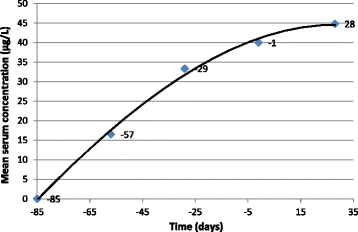Moxidectin steady state prior to inoculation protects cats from subsequent, repeated infection with Dirofilaria immitis
- PMID: 25880531
- PMCID: PMC4340871
- DOI: 10.1186/s13071-015-0710-z
Moxidectin steady state prior to inoculation protects cats from subsequent, repeated infection with Dirofilaria immitis
Abstract
Background: Infection of cats with Dirofilaria immitis causes seroconversion on antibody tests and pulmonary pathology, often without subsequent development of adult heartworms. Consistent administration of topical 10% imidacloprid-1% moxidectin has been shown to result in sustained plasma levels of moxidectin in cats after three to five treatments, a pharmacokinetic behavior known as "steady state".
Methods: To evaluate the ability of moxidectin at "steady state" to protect cats from subsequent infection with D. immitis, cats (n = 10) were treated with the labeled dose of topical 10% imidacloprid-1% moxidectin for four monthly treatments. Each cat was inoculated with 25 third-stage larvae of D. immitis 7, 14, 21, and 28 days after the last treatment; non-treated cats (n = 9) were inoculated on the same days, serving as infection controls. Blood samples were collected from each cat from 1 month prior to treatment until 7 months after the final inoculation and tested for antibody to, and antigen and microfilaria of, D. immitis.
Results: Measurement of serum levels of moxidectin confirmed steady state in treated cats. Cats treated with topical 10% imidacloprid-1% moxidectin prior to trickle inoculation of D. immitis L3 larvae throughout the 28 day post-treatment period remained negative on antibody and antigen tests throughout the study and did not develop gross or histologic lesions characteristic of heartworm infection. A majority of non-treated cats tested antibody positive by 3-4 months post infection (6/9) and, after heat treatment, tested antigen positive by 6-7 months post-infection (5/9). Histologic lesions characteristic of D. immitis infection, including intimal and medial thickening of the pulmonary artery, were present in every cat with D. immitis antibodies (6/6), although adult D. immitis were confirmed in only 5/6 antibody-positive cats at necropsy. Microfilariae were not detected at any time.
Conclusions: Taken together, these data indicate that prior treatment with 10% imidacloprid-1% moxidectin protected cats from subsequent infection with D. immitis for 28 days, preventing both formation of a detectable antibody response and development of pulmonary lesions by either immature stages of D. immitis or young adult heartworms.
Figures


References
-
- Ryan WG, Newcomb KM. Prevalence of Feline Heartworm Disease: A Global Review. Proceedings of the American Heartworm Symposium ’95. Batavia, IL, USA: American Heartworm Society; 1995. pp. 79–85.
-
- Miller MW, Atkins CE, Stemme K, Robertson-Plouch C, Guerrero J. Prevalence of exposure to Dirofilaria immitis in cats in multiple areas of the United States. Vet Ther. 2000;1:169–175. - PubMed
Publication types
MeSH terms
Substances
LinkOut - more resources
Full Text Sources
Other Literature Sources
Miscellaneous

